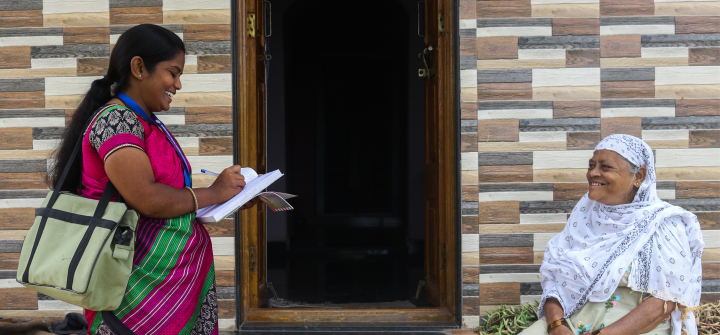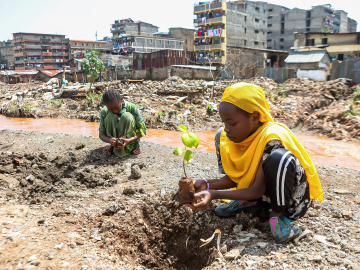Climate Change’s Overlooked Role in Obesity
MUMBAI, India — Sandesh Gholap’s parents never imagined rising temperatures would lead to a weight problem for their 12-year-old son.
Over the past four years, his physical activity has significantly declined as he struggled to play outdoors in Mumbai when summer temperatures in the city topped 39°C (102°F).
The family lives in a bustling neighborhood in Mumbai’s eastern suburbs, surrounded by towering buildings and narrow lanes with few green spaces. The local playground is often empty during scorching heat. With no sports complex nearby and a small park that is far away, he tends to stay indoors.
Sandesh now weighs 50 kilograms (110 pounds) and stands 1.2 meters (4 feet). He gained 10+ kg (22 pounds) in the past year alone, according to his mother, Vaishali Gholap.
Rising Temperatures, Rising Weight
A complex interplay of genetic, behavioral, social, and other factors drives obesity, but climate change’s role remains largely overlooked. “Rising temperatures affect obesity by impacting behavior,” says Maria Teresa Trentinaglia, lead author of a 2021 Global Food Security analysis that explored the issue.
In fact, a 1°C rise in temperature in developing countries was associated with a 4% rise in the BMI of children and a 2% increase in the BMI of women, according to the study. The researchers also found a U-shaped relation between temperature and BMI, meaning BMI tends to increase at both low and high temperatures.
The increasing number of hot days per year experienced worldwide has major implications. Some 6.3 billion people—78% of the world’s population—experienced at least 31 days of extreme heat in the past 12 months, per World Weather Attribution, a collaboration of Imperial College London, The Royal Netherlands Meteorological Institute, and other organizations.
The impact of temperature on obesity occurs over the long term, says Trentinaglia, an assistant professor at the University of Bologna, Italy. In addition to causing people to stay indoors and reduce physical activity, extreme heat can lead to lower crop yields and higher prices for agricultural products. “During such times, people often replace nutritious food with highly processed food, distorting the nutrition pattern,” she says. Processed foods are typically more calorie-dense but less nutritious, contributing to a higher intake of calories.
Climate change is also impacting plants’ protein and micronutrient content. Elevated carbon dioxide levels have been shown to reduce the protein concentration in wheat, rice, barley, and potatoes by 10–15%, according to a 2019 Lancet Commission report. This will further contribute to undernutrition, poorer food choices, and increased prices of nutritious food.
The Hidden Factor
Rising temperatures and undernutrition aren’t climate change’s only connection to increasing obesity rates, says Suraiyya Terdale, a community health worker in Ganeshwadi village in Maharashtra state.
In recent years, the village has been facing recurring floods that destroyed the vegetables and pulses (edible seeds from legume plants like chickpeas and beans) grown in nearby fields. “When it flooded in 2021, people didn’t get nutritious food for two months, and they relied on highly processed food, which started impacting their health,” says Terdale.
Alongside changing eating habits, the changing climate has had direct impacts as well. For example, when people spend less time in cooler temperatures it reduces the body’s need for adaptive thermogenesis, a process by which the body adjusts its energy expenditure in response to environmental conditions, according to a 2021 Hormone and Metabolic Research article. With less energy demand for thermoregulation, overall energy expenditure decreases, potentially increasing the risk of obesity.
In addition, individuals with a high BMI face a greater risk of heat exhaustion during physical activity because they expend additional energy required by greater body weight, which leads to greater heat production, according to a 2020 American Journal of Human Biology article. In Sandesh Gholap’s case, playing outside can quickly leave him breathless. “He just can’t tolerate the heat anymore,” his mother says.
Worldwide, today’s children are 15% less physically fit than their parents were at the same age, according to 2013 American Heart Association review of studies from 28 countries. Factors aside from climate change include sedentary behavior, an increase in screen time, after-effects of the global pandemic, and changes in parental norms and family or peer influences, like “fewer children playing outdoors or less friends to enjoy playing with,” says Shawnda Morrison, PhD, an environmental physiologist at the National University of Singapore.
In addition, a weight problem can lead to bullying and social isolation that makes children reluctant to participate in outdoor activities. Gholap, for example, often experienced bullying. “As a result, he doesn't step out now,” says his aunt Alka Sonawane, adding that he no longer participates in dance or other social activities like group performances at social events.
Limited Solutions
Given the swiftly rising temperatures and obesity rates, solutions—such as increasing the time a child spends in physical education classes—are urgently needed. A government program in Slovenian schools, Morrison notes, added an hour of physical education instruction per week from expert trainers. “The kids that were obese saw the greatest improvements in their body composition,” she says. She notes that these interventions must be implemented for three years or longer and taught by qualified movement trainers to be effective.
Trentinaglia points to a need for country-specific solutions and adaptative interventions like better nutrition literacy and making agriculture climate-resilient by supporting farmers. “Investigating country-level dynamics and patterns is important to understand more about climate change and obesity,” she says.
In Ganeshwadi village, Terdale, the community health worker, is committed to raising awareness of the rising obesity epidemic and the importance of nutritious food. But she hasn’t seen any results yet.
“Now that the climate has changed, we need to find a solution quickly because obesity not just impacts physical health, [it] can ruin someone’s life,” she says.
Ed. Note: This article is part of Global Health NOW’s Local Reporting Initiative, made possible through the generous support of loyal GHN readers.
Join the 50,000+ subscribers in 170+ countries who rely on Global Health NOW summaries and exclusive articles for the latest public health news. Sign up for our free weekday newsletter, and please share the link with friends and colleagues.
Community health worker Suraiyya Terdale raises awareness of rising obesity rates and discusses nutrition literacy in her village in India’s Maharashtra state. September 2, 2024. Sanket Jain




